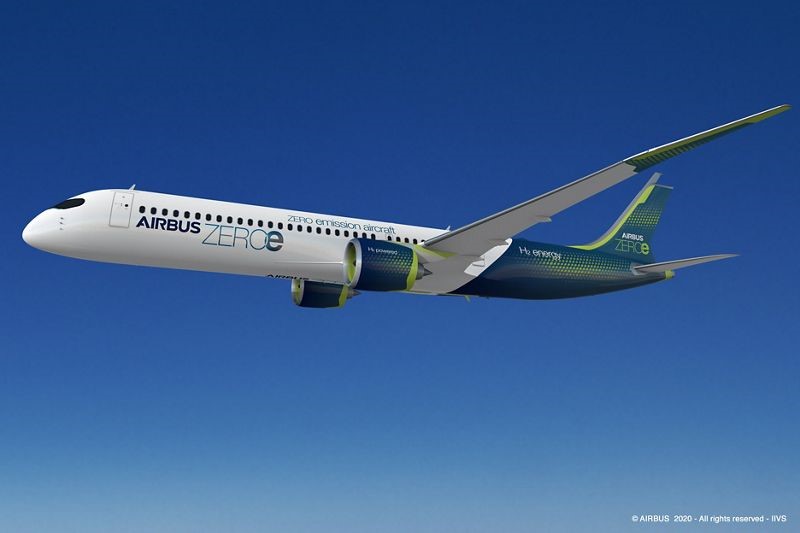Hydrogen as single power source for aircraft propulsion has a large potential to reduce the climate impact of aviation. Compared to present kerosene aircraft, future hydrogen-powered aircraft would avoid any carbon emissions during flight and would have the potential to reduce NOx emissions, but would generate more water emissions. The TRANSCEND project evaluates the emissions of hydrogen-powered regional- and short-range single aisle aircraft with entry into service in 2035. TRANSCEND aims to answer the following questions: How much green hydrogen would be needed for air transport?; How much water would be generated during flight?; and What reduction in NOx emissions could be obtained? To help to answer these questions, NLR’s in-house tool MASS (Mission Aircraft and Systems Simulation for energy performance analysis) was used for preliminary assessments. In the tool, several assumptions with respect to expected technological developments were to be made, which may be subject to uncertainties. A parameter sensitivity analysis of the main assumptions was performed by NLR. In TRANSCEND’s virtual workshop on the 7th of October 2021, experts were invited to discuss the assessment methodology, assumptions, preliminary assessments, and results.
More than 25 experts from aircraft and engine industry, potential key solution providers from other sectors, research organisations, and academia have gathered virtually in the “Hydrogen powered propulsion: from concept to emissions at aircraft level” workshop on 7 October, organized by NLR. Two aircraft types are considered in the assessments: a short range single aisle LH2 turbofan based on A320neo aircraft and a regional LH2 turboprop based on ATR-42 aircraft. Two types of hydrogen-powered propulsion were considered (both separately and combined as hybrid propulsion): hydrogen combustion in adapted turbofans and electric propulsion based on hydrogen fuel cells. NLR’s preliminary results show that fuel cells can be used to assist the combustion engine in the short range single aisle aircraft design, thereby further lowering NOx emissions. The most optimal design point for the regional aircraft (both in terms of energy consumption and emissions) resulted in a fuel cell only configuration. The experts recognized this difference in optimal propulsion configuration between the aircraft types.

Airbus Zero Emission turbofan concept as source of inspiration for the short range single aisle LH2 turbofan of which the preliminary assessment was discussed during the workshop
NLR’s preliminary analysis revealed the importance of assumptions regarding the gravimetric index of liquid hydrogen tanks, fuel cell efficiency and, for the regional LH2 turboprop, fuel cell specific power. Variation in future values for these characteristics have a relatively large effect on the hydrogen consumption at aircraft level and the related emissions. The importance of these parameters was confirmed by the experts.
In break-out sessions for fuel cells, liquid hydrogen tanks, NOx emission for hydrogen combustion, and the design point for fuel cells usage, the experts deeply dived into these subjects. Potential ranges for future values of sensitive parameters were discussed, adjusted and agreed upon. In addition, the experts suggested several opportunities to detail the evaluation model further. For example, for fuel cells the experts pointed to detailing the balance-of-plant: the additional systems needed for fuel cell operation; for fuel tanks constraints for the installation in aircraft were discussed.
Regarding NOx emissions, several experts considered it unlikely that the NOx reduction for hydrogen-powered aircraft will be higher than for kerosene-powered aircraft with the same entry-into-service date. This would still allow substantial reductions of NOx emissions with respect to the present generation of aircraft, but not as high as used in the preliminary analysis.
The experts mentioned various aviation issues for fuel cells, hydrogen tanks, and hydrogen combustion based engines during the break-out sessions. Due to difference with stationary or ground mobile applications, aviation roadmaps are needed for development of fuel cells, hydrogen tanks and hydrogen-powered engines.
TRANSCEND will use the experts feedback to update the assumptions and to detail the modelling approach further. With these updates, TRANSCEND’s final assessments of the emissions of hydrogen-powered regional- and short-range single aisle aircraft with entry into service in 2035 will be performed.